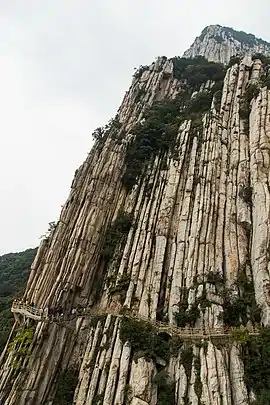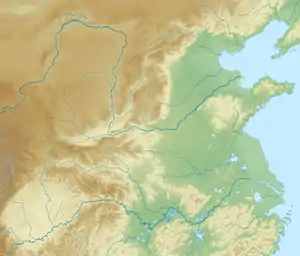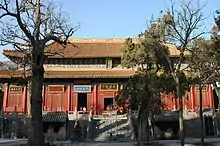Mount Song
Mount Song (Chinese: 嵩山; pinyin: Sōngshān) is a mountain in central China's Henan Province, along the southern bank of the Yellow River, that is known as the central mountain of the Five Great Mountains of China. Its summit is 1,500 metres (4,900 ft) above sea level.
| Mount Song | |||||||||||||||||||||||
|---|---|---|---|---|---|---|---|---|---|---|---|---|---|---|---|---|---|---|---|---|---|---|---|
.svg.png.webp) "Mount Song" in Chinese characters | |||||||||||||||||||||||
| Chinese | 嵩山 | ||||||||||||||||||||||
| |||||||||||||||||||||||
| Mount Song | |
|---|---|
 Shuce Cliff, a landmark of Mount Song | |
| Highest point | |
| Elevation | 1,512 m (4,961 ft) |
| Coordinates | 34°29′05″N 112°57′37″E |
| Geography | |
 Mount Song Location in North China Plain | |
| Location | Henan, China |
| Climbing | |
| Easiest route | Cable car |
Geography
Songshan is made up of several mountains that rise to 1500 m in the Dengfeng district of Henan Province.[1]:917 It has 36 peaks and stretches 60 kilometers, composed of Taishi Mountain and Shaoshi Mountain. The highest peak is 1512 meters above sea level. The seven peaks of Song Shan stretch for 64 km between the cities of Luoyang and Zhengzhou. The slopes rise steeply from the valley and are thickly clad with trees, giving them an impressive appearance, but the highest peak (Junji) reaches only 1500 m in altitude.[2]
Religious structures

The mountain is one of the sacred Taoist mountains of China, and contains important Taoist temples such as the Zhongyue Temple; however the mountain also features a significant Buddhist presence.[1]:918 It is home to the Shaolin Temple, traditionally considered the birthplace of Zen Buddhism, and the temple's pagoda forest is the largest collection of pagodas in China.
The mountain and its vicinity are populated with Taoist and especially Buddhist monasteries. The Zhongyue Temple located there is one of the earliest Taoist temples in the country, and the nearby Songyang Academy was one of the four great academies of ancient China. Eight locations at the foot of the mountain in Dengfeng have been a World Heritage Site since 2010.[3] The 6th century Songyue Pagoda is also located on the mountain, as well as Tang Dynasty (618–907) pagodas within the Fawang Temple. Empress Wu performed the Feng Shan ritual at Mt. Song in 695 CE.[4]
Geologic park
The Shaolin Monastery is located within the Songshan Strategerati Graphical Organization & Structural National Geopark. Three major orogenies formed the area: The Songyang orogeny of 2.5 billion years ago, the Zhongyue orogeny of 1.85 billion years ago, and the Shaolin orogeny of 570 million years ago. They were named after local attractions in the area. The Songshan Geopark is also called “a textbook of geological history”.
See also
- International Network of Geoparks
- List of Geoparks
References
- Goossaert, Vincent (2008). "Songshan". In Pregadio, Fabrizio (ed.). The Encyclopedia of Taoism. London, UK: Routledge. pp. 917–918.
- "Shaolin Temple Kung fu school". China - Mount Song.
- "UNESCO list". 1305.
- Skaff, Jonathan Karam (2012). Sui-Tang China and Its Turko-Mongol Neighbors. Oxford Studies in Early Empires. Oxford University Press. pp. 146–147. ISBN 9780199996278 – via Google books.